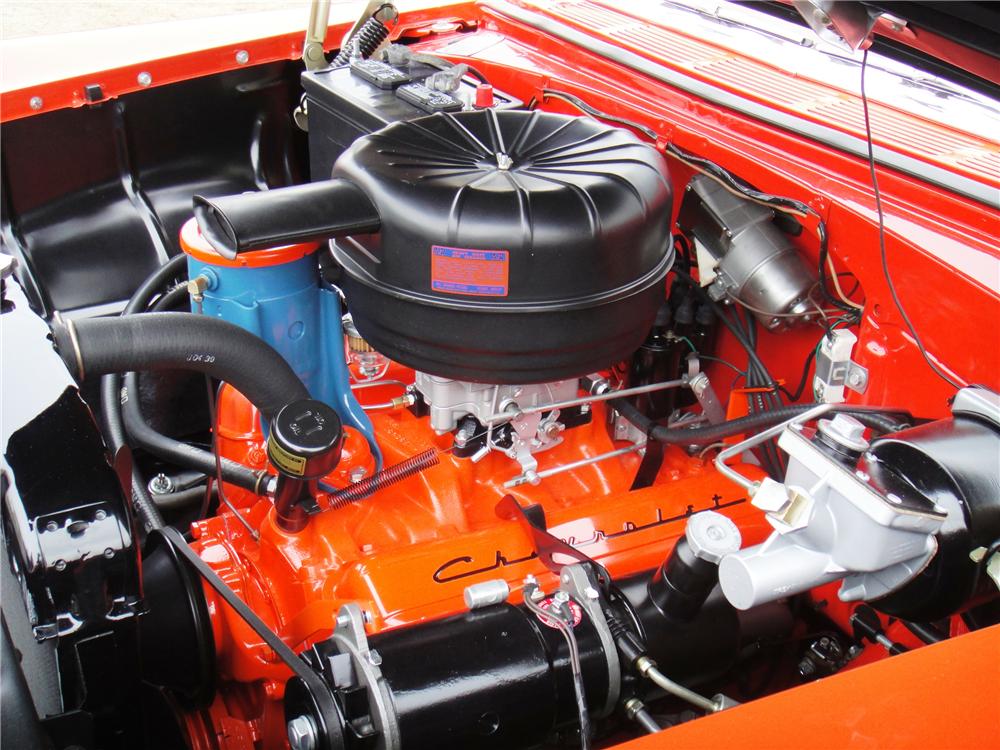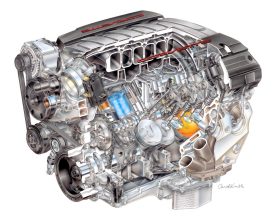The Small Block at 60: History, Facts & More About the Engine That Changed Everything! (original) (raw)
Chevy 265 (image courtesy of Mecum).
The small block Chevy engine wasn’t the first V8 engine. Heck, it wasn’t even Chevrolet’s first V8 engine (Chevy’s “Series D” V8 engine was offered from 1917-’19).
But it was THE V8 engine that changed everything–at least as far as hot rodders are concerned.
This year is the 60th anniversary of the legendary small block Chevy engine, and we’ll be celebrating it accordingly throughout the year. We have to. Whether you’re a Chevy, Ford, Mopar, AMC, or Studebaker guy (or whatever), there’s simply no denying the impact the Chevrolet small block V8 has had on our hobby. This mass-produced engine is the one that made V8 engines more affordable, more compact, more lightweight, and more attainable. Most importantly, the small block has always been loaded with untapped performance potential.
And what hot rodder can’t respect that?
A Brief History
Until the mid 1950s, Chevrolet used six-cylinder engines for its passenger vehicles (except for the short-lived D-Series we mentioned before). However, the Ford Flathead V8 had become popular in the 1950s, particularly with hot rodders because of its increased power potential. Since aftermarket companies were making performance parts for these engines, the hot rod community loved the Flathead. Other manufacturers jumped on the V8 bandwagon–Cadillac with its OHV V8 in 1949, Oldsmobile with its 303-cubic-inch Rocket, and Chrysler with its early HEMI in 1951–but Chevrolet was actually late to the game.
Ed Cole
Enter Ed Cole.
Cole was hired by Chevrolet in 1952 and spearheaded the development of the Gen I small block engine. As chief engineer on the small block project, Cole set out to build a lightweight, inexpensive V8 engine that would outperform anything from the Ford camp. By 1955, when the 265-cubic-inch small block Chevy debuted in the Corvette and Belair, it delivered nearly twice the horsepower (185 horses from the 4-barrel version) as the venerable Flathead in a package that weighed less than Chevrolet’s six-cylinder powerplants.
And that was just the start!
The design and dimensions of the original small block allowed engineers to create different versions by essentially changing bore and stroke size. Soon, the small block lineup included a 283, 327, 350, and even a 400-cubic-inch engine. And because you could interchange parts between all the sizes, the Mouse could be upgraded seemingly countless ways and stuffed into many different vehicles. That, along with the sheer volume of engines available, made the small block Chevy the weapon of choice for power-hungry gearheads.
Over the years, the small block also proved to be quite durable, thanks in part to the use of forged cranks and connecting rods. The performance capability of the engine made it popular for street cars, off-road, trucks, boats, and race cars. What’s more, you can even find small blocks swapped into Fords, Jeeps, and other non-Chevrolet vehicles.
It transcends the hobby!
The small block Chevy has evolved over the past 60 years. We are now on the fifth generation of the small block (the Gen V LT1 V8), but the small block foundation established 60 years ago remains the same: eight cylinders, 90-degree V-formation, single cam pushrod valvetrain, and 4.4-inch bore spacing.
Mouse Party: A Look at the Small Block Proliferation
From that original 265 Turbo Fire V8 to the modern day LT1 version, over 100 million small block Chevys have been produced. Here is a timeline of some (but not all) of the major designs:
265 Turbo-Fire: Introduced in 1955 for the Corvette and Bel Air sedan, this engine would come in three versions the next year: single 4-barrel carb (210 horsepower), twin four-barrel carbs (225 horsepower), and twin four-barrel carbs with high-lift cam (240 horsepower).
283 Turbo-Fire: Featuring a larger bore than the 265, the 283 was first offered in 1957 and came with a choice of carburetion or mechanical fuel injection. The most powerful engine of this group, the fuel-injected Super Ram-Jet was the first to achieve the coveted one horsepower-per-cubic-inch threshold.
327: Starting in 1962, Chevrolet offered a 327-cubic-inch small block by expanding the small block’s bore size to 4.00 inches. The 327 made up to 375 horsepower with a Ram-Jet fuel injection system.
302: Designed in 1966, the 302 was built to help the new Camaro Z/28 meet its obligations for Trans-Am Series (SCCA) competition. Rules limited displacement to 305 cubic inches, so engineers combined the 327 block and its 4.00 bore with the 283’s 3.00-inch stroke crank to reach the magic 302 number. The engine pumped out a conservative 290 horsepower, but race engines with dual-quads were said to have made upwards of 460 horsepower.
Chevy 350
350: Regarded by many as the flag-bearer of the Gen. I small block line, the Chevrolet 350 was first introduced in 1967 as an option for the Camaro. Eventually, the entire Chevy line could be had with the 350, and a bunch of variants began popping up. For example, the L46 offered high performance for the ’67 Camaro, the 1970-72 LT-1 delivered ultra-high performance for the Corvette and Camaro, and later, the L98 introduced tuned-port injection into the equation.
307: Using a larger crankshaft from the 327, the 307-cubic-inch small block was first offered in 1968.
400: Debuting in 1970, the 400 was the largest of the small block family. Known more for its torque, the engine was available in passenger cars through the 1976 model year and lasted through the end of the decade in full-size pickups.
262: In 1975-76, Chevrolet offered the 262 small block, which produced just 110 horsepower. A sign of the times, for sure.
305: In 1977, the 305 replaced the 262 and would eventually become one of GM’s most common V8s during the late 1970s and 80s. Designed as an “economy” engine, the 305 was fairly reliable and fuel efficient while providing respectable power numbers for its day (post muscle car era). Like the 350 it shared its basic architecture with, the 305 was offered in multiple variants over the years.
LS3 small block.
LT1/LT4 (Gen II): The Gen I small block was technically produced for some trucks through 2003, but a second generation was introduced for the 1992 model year. Dubbed the LT1, this engine used the fundamentals of the original small block design, but featured a different cooling system configuration, intake manifold, pulley system, and other components. Eventually, it also utilized sequential port fuel injection. The LT1 came on the Corvette, Camaro, Firebird, and Impala SS among others. The LT4 was the high performance version of the LT1.
LS1/LS6 (Gen III): The LS family of engines was first offered in 1996 with the introduction of the LS1. This engine featured smaller bore and longer stroke than the previous two generations of small blocks and made 345 horsepower in the Corvette. By using better-breathing heads, cam, and intake, the LS6 took things to another level for the Corvette Z06, delivering 405 horsepower at its peak.
LS2: The base engine for the 2005 Corvette and GTO, the LS2 produced roughly 400 horsepower and became the basis for a NASCAR specification engine.
LS7 (Gen IV): Introduced in 2005, the LS7 sported 427 cubic inches, making it the largest small block ever. It featured the same basis 4.4-inch bore spacing, the LS7 took advantage of new technologies in valve timing to produce 505 horsepower.
LS3: Combine an updated version of the LS2 casting (larger bores) with higher-flowing heads, more aggressive camshaft, and revised valvetrain, and you essentially have the LS3. Introduced in 2008 for the Corvette, it delivered 430 horsepower in initial form and has been used in everything from the 2010-up Camaro SS to the Chevrolet SS.
LS9/LSA: Made for the 2009-2013 Corvette ZR1, the LS9 is a supercharged 6.2L engine rated at 638 horsepower–the most powerful of all small blocks. The LSA is a detuned version of the LS9 used for the Cadillac CTS-V and Camaro ZL1.
Gen V LT1/LT4: General Motors introduced the Gen V LT1 for the 2014 Corvette Stingray.
Small Block Facts
- The introduction of the small block V8 in the 1955 Corvette is widely credited with saving the car from cancellation.
- The fuel-injected 283 small block in 1957 was rated at 283 horsepower, or one horsepower for every cubic inch. Today, the Corvette Z06’s 427-cubic-inch small block produces 1.18 horsepower per inch, while the Corvette ZR1’s 376-cubic-inch supercharged small block produces 1.69 horses per inch.
- The fuel-injected small block was so dominant in NASCAR racing in 1957, it was banned.
- Corvette won its first race at LeMans in 1960 with a small block engine and won its seventh title there in June 2011, again with a small block engine.
- The smallest displacement small block V8 ever produced included a 262-cubic-inch (4.3L) version used in the mid-1970s–the same displacement shared by the current small block-based 4.3L V 6.
- The largest displacement small-block for a production vehicle is the 427-cubic-inch (7.0L) LS7.
- The most powerful small block ever produced is the LS9 engine used in the Corvette ZR1. It is rated at 638 horsepower, making it the most powerful engine ever produced by GM for a regular-production car.
- The lowest-output small block was the 1975-76 262 V8 rated at 110 horsepower. The supercharged LS9 makes 580 percent more horsepower than it with only 43-percent greater displacement.
- The 4.3L V6 used today in some GM trucks and vans is based on the original small-block architecture, but essentially with two fewer cylinders.
Gen. V LT-1 engine (image courtesy of General Motors).Original-architecture small block engines are still produced as crate engines for Chevrolet Performance and manufactured for marine and industrial applications.
- Original-architecture small block engines are still produced as crate engines for Chevrolet Performance and manufactured for marine and industrial applications.
- The small block wasn’t known as the small block until Chevrolet introduced the big block engine family in 1965–previously, versions were known simply by their cubic-inch designations, i.e. 283, 327, etc., or simply as the Chevy V8.
Bonus fact: We’ll continue commemorating the small block Chevy with more articles as the year unfolds. Stay tuned!
SOURCES: General Motors, Motor Trend, GM Inside News, Summit Racing




